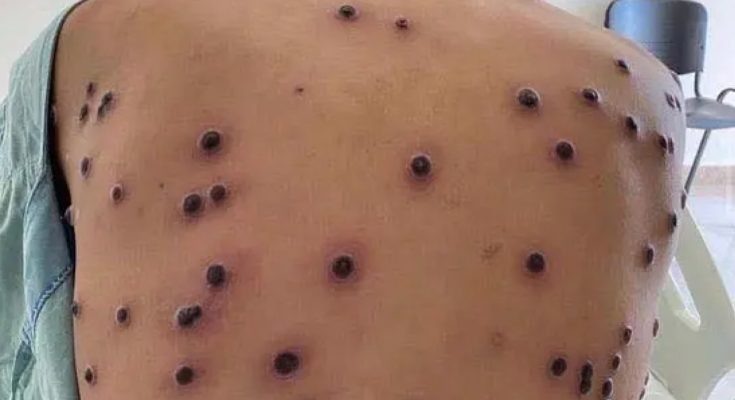A viral infection rash can be caused by a virus such chickenpox, rubella, or measles. A viral rash often occurs with other symptoms associated with the underlying viral infection. This can make it hard to know the source of the rash and the need for treatment.
This article explains how to identify common viral rashes in adults and children based on typical symptoms and unique characteristics. It also discusses treatments and when to seek a medical evaluation for viral rashes.
What Is a Viral Rash?
A viral rash, also known as a viral exanthem, is a skin rash or eruption that commonly occurs as a symptom of a viral infection. It develops as an immune reaction to a virus.
A viral infection rash can usually be identified by red or pink bumps, blotches, or welts that may start on one part of your body and spread, though the appearance can vary by type. It can sometimes cause itching, burning, or other types of discomfort.
In many cases, the virus causing the rash also triggers one or more of the following viral symptoms:1
- Fever
- Chills
- Sore throat
- Headaches
- Fatigue
- Diarrhea and other stomach problems
- Aches and pains
While they can cover large areas of your body and look alarming, viral rashes usually resolve within a few days to a few weeks without treatment.
Spreading Viral Rashes
Viral rashes are typically symptoms of underlying infections. It’s usually the virus, not the rash, that quickly spreads. Some common viral rashes linked to contagious viruses include:
- Measles
- Rubella (German measles)
- Chickenpox
- Hand, foot, and mouth disease
- Fifth disease
- Roseola
Mononuclueosis
Mononucleosis also called the “kissing disease,” is an infection typically caused by the Epstein-Barr virus (EBV). While the disease is most common among teens ages 15 to 17, it can affect people of all ages.2
Mononucleosis can cause a “mono rash” with one of the following characteristics:3
- Macules: Flat discolored areas of the skin
- Petechiae: Small, pinpoint reddish-brown spots
- Scarlatiniform: Small flat blotches that gradually change into fine bumps
- Urticariform: A hive-like rash
- Erythema: Multiforme bulls-eye-shaped lesions
You have up to a 100% chance of developing a pink maculopapular rash if you take an antibiotic like ampicillin or amoxicillin for a throat infection while you have mononucleosis.3 This rash consists of both flat macules and raised bumps called papules.
Shingles Rash
Shingles, also known as herpes zoster, is a viral infection linked to the varicella-zoster virus. This is the same virus that causes chickenpox. If you have had chickenpox, you are at risk of developing shingles. Shingles occurs when the dormant virus is reactivated, usually years after the initial infection.
:max_bytes(150000):strip_icc():format(webp)/VWH_DermNet_Shingles_01-3c25d8bdc2224a4e98ec98d76f4b40af.jpg)
Shingles causes a painful rash that often erupts on one side of your face or body in a single stripe. The blisters last seven to 10 days until they scab over. Full clearing of the rash can take up to four weeks.
Other symptoms of shingles may appear several days before the rash develops and can include:4
- Pain
- Itching
- Tingling
- Burning
Treatment for Shingles Rash
If you think you have shingles, get a medical evaluation as soon as the rash appears. Several antiviral medicines (acyclovir, valacyclovir, and famciclovir) can reduce the length and severity of the illness when taken early in the course of the disease.4
Chickenpox Rash
Chickenpox is a highly contagious viral infection caused by the varicella-zoster virus. The chickenpox rash appears about two weeks after exposure to the virus.
It starts as small red bumps that resemble insect bites or pimples. The bumps develop into fluid-filled blisters over two to four days. After the blisters break, the sores crust over until they become dry, brown scabs.5
The rash first appears on the torso, face, and scalp. It can spread virtually anywhere, including the mouth, eyes, and genitals.
The following people are at high risk for complications from the chickenpox rash:5
- Pregnant persons
- Newborns whose mother had chickenpox
- People with leukemia
- Children taking immunosuppressants
- Individuals with immune system disorders
Fifth Disease
Fifth disease is a mild viral infection that is most common in children and teens. It is caused by human parvovirus B19.
Fifth disease is sometimes called “slapped cheek disease” because it causes a bright red rash on the face, making the child look as if they’ve been slapped.
While the virus can affect both children and adults, the rash is more common in children. The rash appears from four to 14 days after infection. It can spread to other parts of the body and fades after about five to 10 days.6
The rash from fifth disease may reappear when your child is out in the sun or their body heat rises. This can continue for several weeks or months after the illness passes.
Zika Virus
The Zika virus is usually spread by the bite of a certain species of mosquito. It can be spread from a pregnant person to the fetus, through sex, or by an infected blood transfusion.
:max_bytes(150000):strip_icc():format(webp)/VWH_Dermnet_ZikaVirusRash_01-cddb0bdee147482fa856d7101144f591.jpg)
A Zika virus rash is maculopapular. It includes macules (tiny, raised blotches) and papules (reddish bumps). It usually starts on the trunk and spreads to other areas of the body, often causing itching.
Only 20% of people infected with Zika get symptoms. When symptoms occur, they are usually mild, lasting from a couple of days up to a week.7
Pregnancy and Zika Virus
The Zika virus is potentially dangerous for pregnant people. If you become infected with the Zika virus in the early stages of pregnancy, your baby has a higher risk of serious birth defects.8
Hand, Foot, and Mouth Disease
Hand, foot, and mouth disease is a very contagious viral illness caused by the coxsackievirus. It is most common in children under 5 years old.9
The rash usually causes flat, red spots or blisters. These occur on the palms of the hands and the soles of the feet.
When the blisters burst, the sores scab over and dry out. It’s important to avoid touching the blisters since the fluid and resulting scabs may contain the virus and spread the infection.9
Symptoms of hand, foot, and mouth disease may also include sores in the back of the mouth that can blister and cause pain.
HIV Rash
HIV rash occurs during acute HIV infection, the earliest stage of an HIV infection. It typically appears about two to four weeks after initial infection, when the virus is rapidly multiplying.10
An HIV rash can become itchy, red, and painful. It is associated with your body’s reaction to the new virus. It can also be a sign of another viral infection that developed due to a weakened immune system from HIV.
If you have HIV, you can also develop a rash due to medications used to treat HIV or other conditions.
Dangerous HIV Rashes
While most rashes related to HIV medicines are usually not serious, you should call your healthcare provider if you develop a rash while taking HIV medicine. Rarely, these rashes can be a sign of Stevens-Johnson syndrome, a life-threatening hypersensitivity reaction that needs immediate medical care.10
Measles
Measles is a form of paramyxovirus that causes a distinctive rash among people who are not protected by a vaccine. It usually starts on the face about three to five days after viral symptoms begin.
The rash begins as flat red blotches that spread from the face and hairline down to the neck, trunk, arms, legs, and feet. Measles may cause a fever of more than 104°F.11
Tiny raised bumps may develop on top of the flat red spots. The rash usually runs its course in about six days.
While the measles virus is relatively rare due to widespread vaccination, it can cause severe complications for babies and children under age 5.
Roseola Infantum (Sixth Disease)
Roseola infantum, also called sixth disease, is a viral infection caused by a type of herpes virus. Children between 6 months and 2 years old are most often affected by the virus.12
A roseola rash may appear between five and 15 days after exposure. A high fever above 103°F, lasting for up to a week, can occur before the rash appears.
When the rash appears, it is typically pink, with either flat or raised lesions. It usually starts on the abdomen, then spreads to the arms, legs, and face.13
Rubella
Rubella, commonly called German measles, is an infection that mostly affects the skin and lymph nodes. A rash is the first sign of illness after infection.
:max_bytes(150000):strip_icc():format(webp)/rubella-56a245043df78cf77273d5c8.jpg)
A rubella rash usually starts on the face as pink or light red spots and can be harder to see on darker skin. It usually feels rough or bumpy to the touch. It can spread to form colored patches as it moves downward, away from the face.
The rash can be itchy and may last up to three days. The affected skin may shed fine flakes as the rash clears.14
Children who have rubella should never be given aspirin. Doing so puts them at risk for a serious illness called Reye’s syndrome.
Pregnancy and Rubella
If you are pregnant and have symptoms of rubella or learn you’ve been exposed to the virus, contact your healthcare provider immediately. The virus can cause congenital rubella syndrome, resulting in serious birth defects.
West Nile Virus
West Nile virus is an infection transmitted by mosquito bites. About 80% of infected people don’t have symptoms, About 20% of those infected develop a fever with other symptoms including body aches or rash.15
The rash appears two to 14 days after infection. It tends to resemble measles and be maculopapular, with both flat and raised areas. The rash doesn’t itch and often appears on the torso, arms, and legs.16
Dengue Fever
Dengue fever is a viral infection spread by mosquitos. Symptoms include those typical of viral infections. It often starts with a very high fever, up to 105°F, along with a rash.
A dengue fever rash can be macular (flat) or maculopapular (flat and raised). It usually covers most of the body two to five days after the fever starts. Later in the disease, a flat rash similar to measles appears.17
The rash can cause itchiness, skin sensitivity, and general discomfort. The illness and its symptoms usually last about a week.
Molloscum Contagiosum
Molloscum contagiosum is a viral infection caused by poxvirus. The infection causes mild skin disease.
The rash caused by molloscum contagiosum results in the formation of lesions known as mollusca. These lesions can appear anywhere on the body, including the face and genital areas.
Mollusca usually have the following characteristics:18
- Small
- Raised
- Smooth and firm
- White, pink, or flesh-colored pearly appearance
- A dimple or pit in the center
- Diameter of 2 to 5 millimeters
The rash usually clears within six to 12 months without scarring, though it can take as long as four years to disappear.
Colorado Tick Fever
Colorado tick fever is a rare viral tick-borne infection. You can become infected if you are bitten by an infected Rocky Mountain wood tick.
Symptoms of Colorado tick fever, including a skin rash, usually appear within three to seven days of infection, though it can take up to 20 days to see symptoms. In addition to common viral symptoms, a spotted rash occurs in 5% to 12% of people infected with Colorado tick fever.19
Acrodermatitis (Gianitti Crosti Syndrome)
Acrodermatitis, also known as gianitti crosti syndrome, is a rare skin condition. It affects children between the ages of 9 months and 9 years.
The disease usually occurs after a child has had a viral infection such as Hepatitis-B, infectious mononucleosis, coxsackievirus, or cytomegalovirus (CMV).
Acrodermatitis produces a rash that may or may not itch. It is characterized by the following symptoms:20
- Blisters that have large, flat-topped, fluid-filled sacks
- Coverage on the face, arms, legs, or buttocks
- Simultaneous upper respiratory tract infection
- Duration of 20-25 days
While some viral rashes are contagious, others are not. Those that are contagious are usually spread during certain stages of the infection, often before symptoms appear.
Treatment for Viral Rash
Treatments for viral rashes vary depending on the underlying cause of the rash. Many viral rashes don’t require any treatment and clear on their own. Others may benefit from medical care or medication to reduce symptoms and shorten the duration.
The need for treatment of a viral rash depends on the type of rash, your medical history, age, and current physical condition.
Home Remedies
Home remedies can help reduce symptoms of viral rashes that don’t require medical treatment. The following therapies can reduce symptoms, such as itchiness and inflammation, that are common with viral rashes:
- Apply cold compresses on the rash for 15 to 30 minutes several times daily
- Use creams that contain hydrocortisone or calamine to relieve itching
- Apply a paste of two parts baking soda or cornstarch to one part water to the rash
- Take an oatmeal bath
- Use acetaminophen or ibuprofen to reduce fevers that come with viral rashes
- Increase fluid intake
When to See a Healthcare Provider
When a rash doesn’t resolve and you have other symptoms such as fever, body aches, and fatigue, it may be a sign of a more serious condition. Seek immediate medical care if you experience any of the following symptoms:21
- A rash that covers your entire body
- Fever
- Blistering of the rash
- Pain with the rash
- Signs of infection (warmth, red streak, pain)
- The sudden and rapid spread of the rash
- Severe headache
- Stiff neck
- Frequent vomiting or diarrhea
- Change in behavior or personality
- Decrease in food and/or water intake
- Trouble breathing
Is a Viral Rash Serious?
While most viral rashes aren’t considered serious, only a healthcare provider can provide an accurate diagnosis for your rash. Factors such as the type of viral rash you have, your medical history, and your current health condition, can affect the outcomes of a viral rash. If you have a rash, contact your healthcare provider for an accurate diagnosis and treatment plan.
Summary
A viral rash occurs as a symptom of an underlying viral infection. It can appear with other common viral symptoms like fever, headache, body aches, or fatigue.
Most viral rashes start on your trunk or face, then spread to other parts of your body. They can appear in many forms, such as bumps, spots, or blotches.
Viral rashes usually can’t be treated or cured with medicine. They typically heal on their own and disappear as other symptoms of the disease fade.



